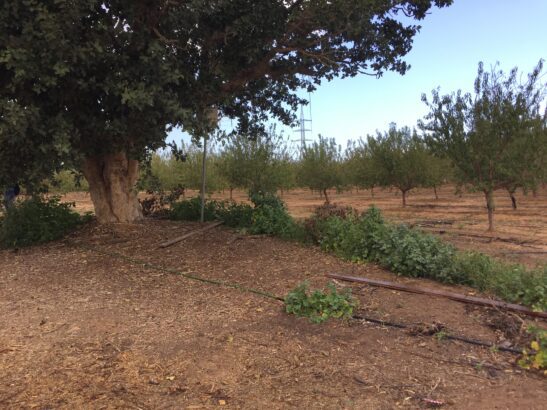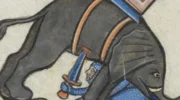One diaspora Palestinian describes her journey to find her family’s destroyed village of Ibdis – and offers a fascinating lesson in Israel’s history of covering up its crimes to help us understand what she found.
by Sarah Aziza, reposted from The Baffler, September 2023
MY LEGS THROBBED, joining my lungs and back in aching protest. I squinted under a flood of Mediterranean sun. Before me, a massive palm tree stood alone, its crown caressing the sky. Its warped, S-shaped trunk was my only anchor in the unmarked, grassy field. This is the place. The thought was a prayer, a drum I tapped continuously, trying to ward off panic. Here. Here. Here.
Aside from the palm, the landscape was shrouded by ten years of change. Dry, scraggly soil had been replaced by thick brush and a commercial almond grove. Even a decade ago, on my first visit to this secluded plain, it had been a challenge to locate the clusters of carved stone that marked the vestiges of my ancestral Palestinian village, ‘Ibdis. Like hundreds of other villages and towns, it was ethnically cleansed by Zionist militias in 1948 during the Nakba, the war in which Israel declared itself a state and displaced over seven hundred thousand Palestinians. Seated in what modern Israel calls the “Northern Negev”—al-Naqab to Arabic speakers—most traces of ‘Ibdis were destroyed.
To locate the remnants of our history, we consulted family stories and a crowdsourced online database. Based on this research, we knew the S-shaped palm tree marked the southeastern corner of the village grounds. On our first visit in 2012, my brother and I fell in line behind my father as he paced a slow line into the past. “They got a new well in 1947—it should be this way. They installed it right before the Nakba,” he murmured. “There was a party that day.” Soon, we stood staring down the well’s dry, silent throat. Nearby, half-hidden by grass, sat the stone slabs of toppled walls and broken graves.
But my father wasn’t there this time. I had spent the last two hours running roughshod through the brush, thatching my arms with cuts, bracing with each footfall to strike some hidden hole or snake. My brother and sister-in-law clambered opposite me. Aside from a few solitary stones, we failed to locate any of the ruins that should have crouched nearby. Worst of all, we found no trace of what, for me, is our village’s crown jewel: the jamayza tree.
Already decades old in my grandmother’s youth, the sycamore fig branched thick and high, arching at the edge of the village, bearing shade and thrice-yearly fruit. A pre-Nakba map named the local valley after her (in my mind, the tree is she): Wad-al-Jamayza. Her spreading branches loomed in family lore as an oasis between home and field, a place where farmers reclined and children played.
In 2012, my father, brother, and I had entered the shelter of her limbs, finding cool relief after our breathless trek across razed earth. Beneath her dusky leaves, the land was littered with small, near-ripe figs. We held the small fruit wistfully, a sweetness we would not know. But the greater emotion was exuberance. For a moment, the tree’s materiality felt like victory: a chance to touch our roots.
I have spent the years since that day clasping the memory of that gentle giant with equal parts love and fear. Her silhouette, framed by that field of absences, looked so tenuous. Her body was a glitch in an imperialist machine that none of us were meant to survive. My grandmother had died two years before our first visit to ‘Ibdis, and though she was buried in Saudi Arabia, her final country of exile, the jamayza always felt like her true resting place. In the countless nights I dreamed of her, I often pictured this tree. She’d been a refugee for forty-three years by the time I was born, meaning I’d never seen her, truly, at home. I needed her to have that shelter. I needed it too.
And then came my return in March 2023. Shuddering and sweat-slicked, I confronted my secret dread. An almond grove stood precisely where the jamayza should have been. A phalanx of tight, straight rows arrayed atop our history.
The Lie of the Land
To another’s eye, the transformation of this land might be viewed as “progress”: in 2012, the ground was mostly bare, a crust of soil dotted with wan watermelons. (We pilfered one, cracking it open under the jamayza tree, discovering its insides were parched and pale.) Now, the almond trees make for a lush multitude, a rippling green horizon that stretches for a quarter mile in every direction. In this, the land of ‘Ibdis seems to reflect the familiar Zionist claim of having “made the desert bloom.” [more]
Sarah Aziza is a writer who splits her time between New York City and the Middle East. Her work has appeared in the New York Times, The New Yorker, the Washington Post, Harper’s, and The Intercept, among other publications. Her first book, a hybrid work exploring the intertwined legacies of diaspora, colonialism, and the American dream, will be published by Catapult.





